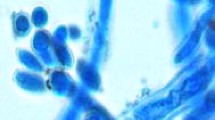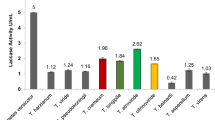Abstract
Laccase can catalyze the oxidation of a wide range of organic and inorganic substrates. In this study, an easily detectable method was employed for screening laccase-producing microorganisms by using 2,2′-azino-bis(3-ethylbenzothiazoline-6-sulfonate) (ABTS) as laccase-secretion indicator. A novel laccase-producing strain was isolated and identified as Paecilomyces sp. WSH-L07 according to the morphological characteristics and the comparison of internal transcribed spacer (ITS) ribosomal DNA (rDNA) gene sequences. In further investigation, the production of laccase by Paecilomyces sp. WSH-L07 was greatly enhanced by the nontoxic inducers of copper sulphate and methylene blue. Under the induction of 50 µM copper sulphate and 20 µM methylene blue, the maximum laccase production was obtained. When these inducers were added into cultivation medium at 24 h and 12 h, respectively, an increment of about 100 times of laccase activity compared with that of in inducer-free medium and about two times of that of in single copper-supplemented medium was observed. Compared with other Paecilomyces species, Paecilomyces sp. WSH-L07 exhibit the better laccase-producing characteristics with an activity of 1,650 U/l on the eighth day, suggesting its potential ability for industrial application.





Similar content being viewed by others
References
Alexandre G, Zhulin IB (2000) Laccases are widespread in bacteria. Trends Biotechnol 18:41–42
Bourbonnais R, Paice MG (1990) Oxidation of non-phenolic substrates: an expanded role for laccase in lignin biodegradation. FEBS Lett 267:99–102
Chen Q, Hang J, Shi YY, Xiao YZ, Wu J, Hong YZ, Wang YP (2004) Selective induction, purification and characterization of a laccase isozyme from the basidiomycete Trametes sp. AH28–2. Mycologia 96:26–35
Danneel HJ, Ullrich M, Giffhorn F (1992) Goal-oriented screening method for carbohydrate oxidases produced by filamentous fungi. Enzyme Microb Technol 14:898–903
Galhaup C, Goller S, Peterbauer CK, Strauss J, Haltrich D (2002) Characterization of the major laccase isoenzyme from Trametes pubescens and regulation of its synthesis by metal ions. Microbiology 148:2159–2169
Galhaup C, Wagner H, Hinterstoisser B, Haltrich D (2002) Increased production of laccase by the wood-degrading basidiomycete Trametes pubescens. Enzyme Microb Technol 30:529–536
Gnanamani A, Jayaprakashvel M, Arulmani M, Sadulla S (2006) Effect of inducers and culturing processes on laccase synthesis in Phanerochaete chrysosporium NCIM 1197 and the constitutive expression of laccase isozymes. Enzyme Microb Technol 38:1017–1021
Hao JJ, Song FQ, Huang F, Yang CL, Zhang ZJ, Zheng Y, Tian XJ (2007) Production of laccase by a newly isolated deuteromycete fungus Pestalotiopsis sp. and its decolorization of azo dye. J Ind Microbiol Biotechnol 34:233–240
Hattori M, Konishi H, Tamura Y, Konno K, Sogawa K (2005) Laccase-type phenoloxidase in salivary glands and watery saliva of the green rice leafhopper, Nephotettix cincticeps. J Insect Physiol 51:1359–1365
Hoshida H, Fujita T, Murata K, Kubo K, Akada R (2005) Copper-dependent production of a Pycnoporus coccineus extracellular laccase in Aspergillus oryzae and Saccharomyces cerevisiae. Biosci Biotechnol Biochem 69:1090–1097
Kluczek-Turpeinen B, Tuomela M, Hatakka A (2003) Lignin degradation in a compost environment by the deuteromycete Paecilomyces inflatus. Appl Microbiol Biotechnol 61:374–379
Labbe S, Thiele DJ (1999) Copper ion inducible and repressible promoter systems in yeast. Method Enzymol 306:144–153
Leonowicz A, Cho NS, Luterek J, Wilkolazka A, Wojtas-Wasilewska M, Matuszewska A, Hofrichter M, Wesenberg D, Rogalski J (2001) Fungal laccase: properties and activity on lignin. J Basic Microbiol 41:185–227
Liang ZQ, Han YF, Chu HL (2007) A new thermotolerant Paecilomyces species which produces laccase and a biform sporogenous structure. Fungal Divers 27:95–102
Malhotra K, Sharma P, Capalash N (2004) Copper and dyes enhance laccase production in γ-proteobacterium JB. Biotechnol Lett 26:1047–1050
Malmstrom BG, Reinhammar B, Vanngard T (1970) The state of copper in stellacyanin and laccase from the lacquer tree Rhus vernicifera. Biochim Biophys Acta 205:48–57
Marjasvaara A, Torvinen M, Vainiotalo P (2004) Laccase-catalyzed mediated oxidation of benzyl alcohol: the role of TEMPO and formation of products including benzonitrile studied by nanoelectrospray ionization Fourier transform ion cyclotron resonance mass spectrometry. J Mass Spectrom 39:1139–1146
Mayer AM, Staples RC (2002) Laccase: new functions for an old enzyme. Phytochemistry 60:551–565
Miller GL (1959) Use of dinitrosalicylic acid reagent for determination of reducing sugar. Anal Chem 31:426–428
Mohandass C, Knutson K, Ragauskas AJ (2008) Laccase treatment of recycled blue dyed paper: physical properties and fiber charge. J Ind Microbiol Biotechnol 35:1103–1108
Ronne H (1995) Glucose repression in fungi. Trends Genet 11:12–17
Tavares APM, Coelho MAZ, Coutinho JAP, Xavier A (2005) Laccase improvement in submerged cultivation: induced production and kinetic modelling. J Chem Technol Biotechnol 80:669–676
Vasconcelos AFD, Barbosa AM, Dekker RFH, Scarminio IS, Rezende MI (2000) Optimization of laccase production by Botryosphaeria sp. in the presence of veratryl alcohol by the response-surface method. Process Biochem 35:1131–1138
Wong YX, Yu J (1999) Laccase-catalyzed decolorization of synthetic dyes. Water Res 33:3512–3520
Yaropolov AI, Skorobogatko OV, Vartanov SS, Varfolomeyev SD (1994) Laccase: properties, catalytic mechanism, and applicability. Appl Biochem Biotechnol 49:257–280
Zhao J, Kwan HS (1999) Characterization, molecular cloning, and differential expression analysis of laccase genes from the edible mushroom Lentinula edodes. Appl Environ Microb 65:4908–4913
Acknowledgments
This work was supported by the National Outstanding Youth Foundation of China (no. 20625619), the Major State Basic Research Development Program of China (973 Program) (no. 2007CB714306), the Program for Changjiang Scholars and Innovative Research Team in University (no. IRT0532), New Century Excellent Talents in University (NCET-05-0488 and NCET-07-0378).
Author information
Authors and Affiliations
Corresponding authors
Rights and permissions
About this article
Cite this article
Liu, Z., Zhang, D., Hua, Z. et al. A newly isolated Paecilomyces sp. WSH-L07 for laccase production: isolation, identification, and production enhancement by complex inducement. J Ind Microbiol Biotechnol 36, 1315–1321 (2009). https://doi.org/10.1007/s10295-009-0615-y
Received:
Accepted:
Published:
Issue Date:
DOI: https://doi.org/10.1007/s10295-009-0615-y




